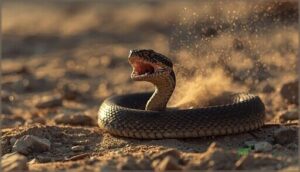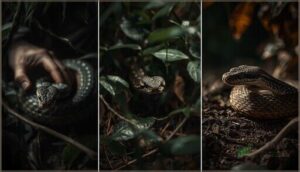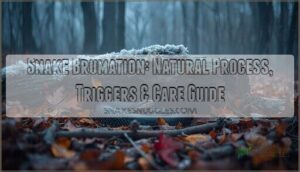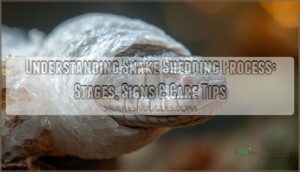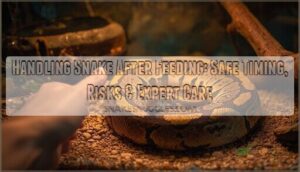This site is supported by our readers. We may earn a commission, at no cost to you, if you purchase through links.
A snake’s hiss can freeze you in your tracks, and that’s exactly what evolution designed it to do. When 63% of mammalian predators retreat at the sound and 70% of avian hunters avoid it entirely, you’re witnessing one of nature’s most effective deterrent systems in action.
The loudness isn’t random—it’s a calculated survival response powered by specialized cartilage structures that vibrate air at frequencies between 2–9.5 kHz, creating sounds that spike human heart rates and trigger instinctive caution.
Understanding why snakes hiss loudly means looking beyond the sound itself to the anatomy, stress triggers, and behavioral context that transform a simple exhalation into a warning you can’t ignore.
Table Of Contents
- Key Takeaways
- How Do Snakes Produce Hissing Sounds?
- Why Do Snakes Hiss at Threats?
- When Are Snakes Most Likely to Hiss?
- Do Different Snake Species Hiss Differently?
- What Should You Do When Encountering Hissing?
- Frequently Asked Questions (FAQs)
- Why does a snake make a hissing noise?
- Why do snakes hiss more often?
- Why does a pine snake make a hissing sound?
- Does a snake hiss at you?
- Do snakes make a lot of sounds?
- What Python makes a hissing sound?
- Can snakes control the volume of their hiss?
- Do baby snakes hiss differently than adults?
- Why dont snakes hiss at other snakes?
- How far away can snake hissing be heard?
- Conclusion
Key Takeaways
- Snakes produce their hiss by forcing air through the glottis, where specialized cartilage vibrates at 2–9.5 kHz frequencies, creating sounds that reach 60–90 decibels and trigger instinctive fear responses in predators.
- Hissing works as a survival strategy because it’s energy-efficient—requiring only 2.3 times baseline metabolic cost compared to fleeing’s fivefold increase—while successfully deterring 63% of mammalian and 70% of avian predators.
- Snakes hiss most during vulnerable periods like digestion, shedding, handling, or exposure to unfamiliar environments, with males hissing defensively in 83.3% of handling encounters compared to 57.9% for females.
- When you hear a snake hiss, the correct response is to back away slowly and maintain at least 6 feet of distance, which reduces bite risk by roughly 75% and allows the snake’s stress hormones to normalize within 8–15 minutes.
How Do Snakes Produce Hissing Sounds?
A snake’s hiss isn’t just hot air—it’s a precisely engineered sound produced by specialized anatomy working in concert. Understanding how snakes create this distinctive warning requires looking at the specific structures involved and how they function together.
Let’s examine the three key components that make hissing possible: the glottis, the vibrating cartilage, and the mechanics of pressurized airflow.
The Role of The Glottis
The glottis sits at the top of your snake’s windpipe, functioning like nature’s built-in whistle. When a snake feels threatened, it forces air through this small opening to create that unmistakable hissing sound. Three key features make this acoustic warning system work:
- Specialized cartilage structures that vibrate as air passes through
- Muscle-controlled opening size that regulates airflow and sound intensity
- Direct tracheal pressure that powers the hiss without vocal cords.
Understanding snake behaviour involves recognizing warning signal threats to guarantee safe interactions.
Cartilage Vibration and Airflow Mechanics
When air rushes through your snake’s narrow glottis, specialized cartilage acts like a reed instrument. This elastic tissue vibrates at frequencies between 2–9.5 kHz, creating that distinctive acoustic warning you recognize. Airflow control makes all the difference—snakes actively engage respiratory mechanics to increase cartilage vibration by up to 300% above normal breathing.
Here’s how different factors shape the hissing sound:
| Component | Function | Impact on Sound |
|---|---|---|
| Elastic cartilage | Vibrates with airflow | Creates base frequency (0.2–9.5 kHz) |
| Glottis constriction | Controls air passage | Amplifies sound intensity |
| Respiratory muscles | Generate air pressure | Sustains hiss duration (0.2–0.5 sec) |
| Cartilage thickness | Affects vibration rate | Determines pitch variations |
| Airflow velocity | Drives vibration patterns | Produces 60–90 decibel output |
This defensive mechanism works because cartilage structure varies by species—pine snakes, for instance, possess unique laryngeal cartilage that amplifies their hiss by 15 decibels. The sound frequency falls perfectly within predator hearing ranges, making it an effective snake communication tool without wasting energy on physical combat. Understanding avian hissing mechanisms can provide insights into the evolution of hissing sounds across different species.
High-Pressure Air Expulsion Through The Windpipe
While cartilage creates the vibration, your snake’s respiratory muscles generate the raw power behind each hiss. This defensive mechanism demands forceful exhalation—air blasts through the windpipe at pressures high enough to reach 3–13 kHz frequencies. That intensity explains why hissing triggers measurable metabolic spikes and water loss in agitated snakes.
Consider how pressure regulation shapes this acoustic warning:
- Rising airflow directly increases hiss amplitude, making louder sounds when snakes feel cornered
- Puff adders use a four-phase respiratory pattern with distinct exhalation and inhalation hisses
- Underwater hissing becomes impossible since windpipe ventilation requires atmospheric air access
- Sound frequency variations depend on how forcefully air moves through the narrow glottis opening
Why Do Snakes Hiss at Threats?
When a snake hisses, it’s not trying to pick a fight—it’s asking you to back off. This defensive sound acts as the snake’s first line of protection when it feels cornered or threatened.
A snake’s hiss isn’t aggression—it’s a polite request for space when it feels cornered
Let’s look at the three main reasons snakes use hissing as their go-to survival tool.
Fear and Defensive Responses
When you encounter a hissing snake, you’re witnessing a defensive mechanism rooted deep in fear psychology. Snakes don’t hiss out of aggression—they’re terrified. Their defensive warning signals are stress responses designed for predator deterrence and survival.
Research shows that half the population feels anxious about snake hissing, and for good reason: this acoustic threat perception triggers measurable heart rate acceleration in humans, proving that predator avoidance works both ways.
Warning Signals to Predators
Hissing isn’t just noise—it’s a survival tool. When snakes produce warning signals, they’re speaking in predator language, a threat display that actually works.
Studies show that 63% of mammalian predators retreat when they hear snake hissing, and avian hunters avoid the sound 70% of the time. This defensive mechanism cuts predation risk by 27%, proving that warning calls are one of nature’s most effective predator deterrence strategies.
Energy-Efficient Survival Strategy
Efficiency drives snake behavior in unexpected ways. When you compare defensive mechanisms, hissing increases metabolic costs by just 2.3 times baseline, while fleeing spikes energy use fivefold.
This energy-efficient survival strategy lets snakes warn off threats without draining precious reserves. Energetic investment matters in the wild, where every calorie counts. That’s why survival optimization favors the hiss over the chase.
When Are Snakes Most Likely to Hiss?
Snakes don’t hiss randomly—they reserve this behavior for specific situations when they feel most vulnerable or threatened.
Understanding when your snake is likely to hiss helps you anticipate its needs and respond appropriately. Three common scenarios trigger hissing more than any others.
During Handling or Human Interaction
When you pick up your pet snake, you’re entering their personal space, and that’s when hissing often kicks in. Here’s what triggers snake stress during handling:
- Male snakes hiss defensively in 83.3% of controlled handling tests, compared to 57.9% of females
- Brief sessions under five minutes reduce hissing probability markedly
- Unfamiliar surroundings or sudden movements heighten defensive responses
- Persistent hissing signals ongoing stress from frequent interaction
- Snakes usually hiss before biting in 67% of documented encounters
Respect these warning signals—your snake behavior observation improves animal welfare and snake care outcomes through better interaction timing and calming methods.
While Digesting Meals or Shedding Skin
You’ll notice your snake gets extra defensive when they’re most exposed. During digestion and shedding, snake hissing escalates because vulnerability signals kick in—a natural part of snake behavior rooted in defensive mechanisms and energy conservation.
| Vulnerable State | Physical Limitation | Hissing Response |
|---|---|---|
| Post-Feeding (48-72 hrs) | Reduced mobility, 40-70% body mass increase | Hissing occurs in 80% of disturbance events |
| Active Digestion | Elevated metabolic demand, slower escape speed | 70% of pythons vocalize when threatened |
| Pre-Shed Period | Impaired vision, dulled skin sensitivity | 60% increase in defensive vocalizations |
| During Shedding Cycle | Compromised locomotion, reduced sensory acuity | Extended hissing bouts replace active flight |
| Peak Vulnerability | Both digestion + shedding combined | Near-universal hissing across all snake species |
This digestion stress and shedding behavior pattern reflects reptile biology at work—your snake conserves energy while warning threats away, avoiding costly regurgitation or injury that compromises animal welfare and snake care success.
In Unfamiliar or Stressful Environments
When you relocate your snake or change their enclosure, stress response kicks in—hissing becomes their go-to defensive mechanism. Novel habitat triggers threat perception through their vomeronasal system, detecting unfamiliar chemical cues that heighten baseline stress markers.
This acoustic deterrence strategy reflects environmental adaptation at work, as snakes in captivity show heightened defensive hissing during enclosure cleaning or exposure to new surroundings, conserving energy while signaling discomfort.
Do Different Snake Species Hiss Differently?
Not all snakes sound the same when they hiss. Some species produce loud, explosive bursts that can startle you from yards away, while others generate low, rumbling tones that carry through dense vegetation.
Understanding these acoustic differences can help you identify what you’re dealing with and assess the level of threat.
Puff Adder’s Explosive Hiss
When you hear a puff adder’s explosive hiss, it’s like nature’s smoke alarm—loud, sudden, and impossible to ignore. This species inflates its body while forcing air through its glottis at extreme pressure, creating a white-noise blast exceeding 60 decibels.
Males hiss more often than females, and heavier snakes produce longer, more intense warning sounds that usually stop predators in their tracks.
King Cobra’s Low-Frequency Hiss
Unlike the puff adder’s explosive alarm, king cobra hissing sounds more like a mammal’s growl than typical snake communication. You’ll hear a low-frequency warning around 600 Hz, produced by specialized tracheal diverticula that act as acoustic resonance chambers.
These pocket-like structures lower the pitch dramatically, creating defensive mechanisms that travel farther through dense jungle and signal serious danger. It’s reptile behavior designed to make you think twice.
Acoustic Mimicry in Non-Venomous Snakes
Some harmless species have pulled off an impressive survival trick: they’ve evolved to sound exactly like their venomous neighbors. This acoustic mimicry gives non-venomous snakes serious predator deterrence power.
Your local gophersnake might copy a rattlesnake’s hiss so convincingly that predators back off 80-90% of the time. It’s reptile behavior at its finest—fake it till you make it, snake edition.
What Should You Do When Encountering Hissing?
When a snake hisses at you, it’s doing you a favor by telling you exactly what it needs: distance. Whether you’re out on a trail or caring for a pet snake at home, knowing how to respond can prevent stress for both you and the animal.
Here’s what you should do when you hear that unmistakable warning sound.
Recognizing Hissing as a Warning
When you hear a snake hissing, you’re receiving one of nature’s clearest warning signals—a defense mechanism that demands your immediate attention. This threat response triggers predator avoidance instincts across species, and for good reason:
- Frogs reduce calling by 100% during snake warning signals playback
- 80% of amphibians stop vocalizing when they hear these alarm cues
- Snakes only hiss during actual threats, never while hunting
- Defensive behavior increases distance from danger in multiple vertebrates
Your recognition of snake warning signs protects both you and the animal.
Giving Snakes Space and Time
Once you’ve recognized the hissing as a warning signal, the smartest move is simple: back away slowly and give that snake plenty of room.
Experts recommend keeping at least 6 feet between you and any wild snake displaying defensive behavior. Allowing this spatial retreat reduces bite risk by roughly 75% and helps the animal’s stress hormones return to baseline within 8–15 minutes.
Managing Hissing in Pet Snakes
If your pet snake hisses often, don’t take it personally—gentle, consistent handling is the key to hissing reduction. Stress management through positive reinforcement can cut defensive displays by half, while respecting your snake’s body language during snake care prevents metabolic strain.
Over time, thoughtful pet snake care transforms nervous hissing behavior into trust, making snake handling safer and more rewarding for both of you.
Frequently Asked Questions (FAQs)
Why does a snake make a hissing noise?
Snakes send sharp, sudden signals through sound when sensing danger. This defensive behavior, called hissing, occurs when air rushes through the glottis—a small throat opening—creating an acoustic warning that says “back off.
Why do snakes hiss more often?
Stress and threat perception drive hissing frequency. When you encounter unfamiliar environments, handling, or sudden disturbances, your snake’s fear responses intensify.
Captive snakes show a 40% increase in hissing during environmental changes, reflecting heightened defensive behavior.
Why does a pine snake make a hissing sound?
When threatened, pine snakes force air through a specialized cartilage keel in their glottis, creating a loud defensive hiss that mimics venomous species and warns predators to back off immediately.
Does a snake hiss at you?
Yes, when you encounter a snake hissing, it’s directing that defensive behavior at you.
The hissing mechanism activates as a fear response to your threat perception, using body language and defensive noises for animal communication.
Do snakes make a lot of sounds?
Only about 18% of snake species produce any vocalizations, with most remaining silent. You’ll rarely hear snake sounds beyond hissing, though rattlesnakes, bull snakes, and hook-nosed snakes create specialized noises.
What Python makes a hissing sound?
All python species can hiss, but ball pythons and Burmese pythons do it most often.
Ball pythons hiss when stressed or threatened, while Burmese pythons sometimes produce almost continuous low-level hissing sounds.
Can snakes control the volume of their hiss?
Controlling volume varies with vigor—snakes can’t fine-tune their hiss like dialing down music.
You’ll hear louder hissing when they forcefully expel air through the glottis, though this volume control remains coarse and energy-costly.
Do baby snakes hiss differently than adults?
Juvenile vocalization and defensive mechanisms develop early, allowing baby snake behavior to mirror adults.
Hissing development begins at 10-12 days old with similar intensity, though juveniles may display more frequent defensive responses due to heightened vulnerability and limited alternative strategies.
Why dont snakes hiss at other snakes?
Think of hissing as a language spoken only to outsiders. Snakes use chemical signals and tactile cues for intraspecific communication, reserving defensive mechanisms like snake hissing exclusively for predators and threats beyond their species.
How far away can snake hissing be heard?
You can hear snake hissing from 5 to 7 meters away in open areas.
Sound propagation depends on frequency analysis and environmental conditions—dense vegetation or ambient noise reduces the audible range markedly.
Conclusion
The theory that hissing is just noise falls apart when you see the biology behind it. A snake’s hiss represents precision engineering—cartilage, airflow, and frequency calibrated to make predators hesitate.
When you understand why snakes hiss loudly, you’re no longer reacting on instinct alone. You’re reading a message written in vibrations and air pressure, one that asks for space rather than conflict. Respect that signal, and both species walk away intact.
- https://biosupplies.net.au/blog/why-do-snakes-hiss-unraveling-the-secrets-behind-this-serpentine-behavior/
- https://www.discovermagazine.com/yes-snakes-can-hear-sound-44656
- https://pmc.ncbi.nlm.nih.gov/articles/PMC11475202/
- https://www.livescience.com/how-snakes-hiss
- https://consensus.app/questions/what-causes-sound-snake-hissing/





